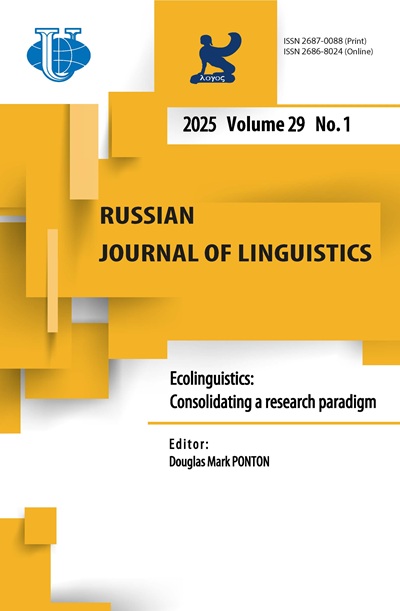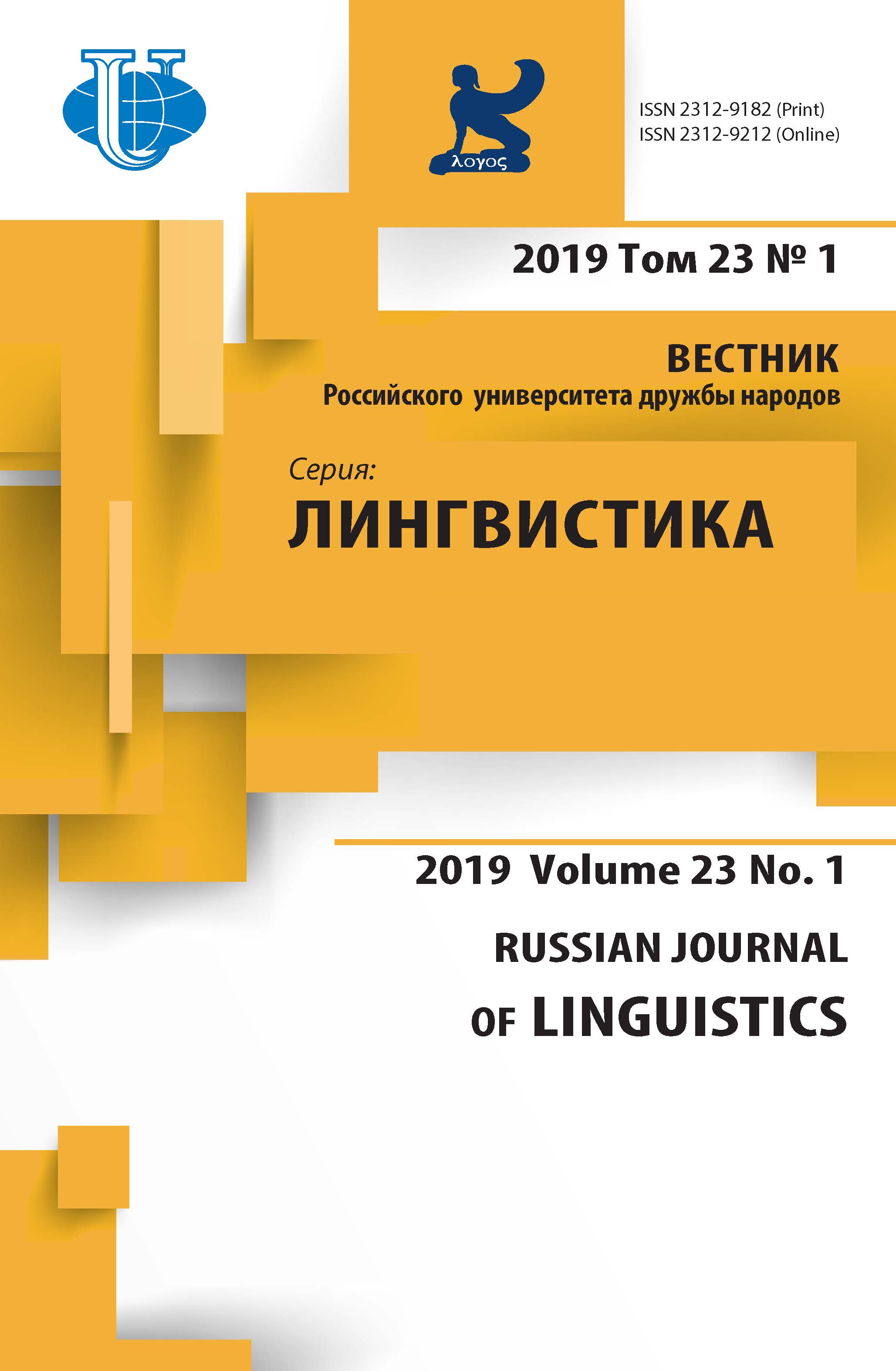Cultural bias and Sociolinguistics
- Authors: Smakman D.1
-
Affiliations:
- Leiden University, Centre for Linguistics
- Issue: Vol 23, No 1 (2019)
- Pages: 9-22
- Section: SOCIOLINGUISTICS
- URL: https://journals.rudn.ru/linguistics/article/view/20613
- DOI: https://doi.org/10.22363/2312-9182-2019-23-1-9-22
Cite item
Full Text
Abstract
Peoples and individuals around the globe continuously develop their own communicative habits. With each generation, adjustments to changing circumstances are made - economic circumstances, natural circumstances, and, for instance, mobility circumstances. The outcome of such transitions is cultural variation, which is visible in hierarchical social systems, belief systems, legal systems, traditions, attire, and all kinds of rituals. Communicative systems are part of culture, and they deserve a role in research focussing on language and communication. However, applying culture as a variable is a challenge, not only because of the cultural variation between peoples and individuals but also because the effects of culture on actual language utterances are hard to measure. Another issue is the dominance of Anglowestern cultural patterns in many analyses. This paper explains these issues and critically reviews the various criteria that well-known cultural models - like the one by Hofstede (1980), Lewis (1969), and Hall (1959, 1976) - use to categorise cultures. Examples of such criteria are: region, relationship with uncertainty, femininity/masculinity, and power relations. The paper concludes by giving a number of practical solutions to the challenge of treating culture as a variable in sociolinguistic research. These solutions are related to, amongst others, the reviewing process for journals, widespread norms of ‘good academic language’, author/editor selection, cross-cultural academic cooperation, and sharing of funds.
About the authors
Dick Smakman
Leiden University, Centre for Linguistics
Email: d.smakman@hum.leidenuniv.nl
Ph.D., Lecturer at Leiden University Centre for Linguistics, Department of English. His research interests embrace sociolinguistics, phonetics, language learning and teaching, Dutch, English PO Box 9515, 2300 RA, Leiden, Netherlands
References
- Ball, M. J. (Ed.) (2010). The Routledge Handbook of Sociolinguistics around the World. London: Routledge.
- Bauman, Z. (2000). Liquid Modernity. Cambridge: Polity Press.
- Bolton, K., & Kwok, H. (Eds.). (1992). Sociolinguistics Today; International Perspectives. London, New York Routledge.
- Coulmas, F. (2013). Sociolinguistics. The Study of Speakers’ Choices. Cambridge: Cambridge University Press.
- Eisenstadt, S. N. (1973). Tradition, Change and Modernity. New York: Wiley.
- Evans-Pritchard, E. E. (1951). Social Anthropology. London: Cohen & West Ltd.
- Fairclough, N. (2003). Political Correctness: The Politics of Culture and Language. Discourse and Society, 14(1), 17-28.
- Giddens, A. (1991). Modernity and self-identity. Self and society in the late modern age. Cambridge: Polity Press.
- Gould, S. J. (2000). Wonderful Life. The Burgess Shale and the Nature of History. New York: Vintage.
- Greenberg, M. L. (2015). The Slavic area. Trajectories, borders, centres and peripheries in the Second World. In D. Smakman & P. Heinrich (Eds.), Globalising Sociolinguistics. Challenging and Expanding Theory (pp. 164-177). London: Routledge.
- Hall, E. T. (1959). The Silent language. New York: Doubleday.
- Hall, E. T. (1976). Beyond Culture. New York: Doubleday.
- Halliday, M. A. K. (2001). New ways of meaning. The challenge to applied linguistics. In A. Fill & P. Mühlhäusler (Eds.), The Ecolinguistic Reader (pp. 175-202). London: Continuum.
- Halman, L., Inglehart, R. F., Díez-Medrano, J., Luijkx, R., Moreno, A., & Basáñez, M. (2008). Changing Values and Beliefs in 85 Countries. Trends from the Values Surveys from 1981 to 2004. Leiden: Brill.
- Hofstede, G. (1980). Culture's Consequences: International Differences in Work-Related Values. Beverly Hills CA: Sage Publications.
- Hofstede, G. (n.d.). Hofstede insights. Retrieved from https://www.hofstede-insights.com.
- Hofstede, G., Hofstede, G. J., & Minkov, M. (2010). Cultures and Organizations: Software of the Mind (3 ed.). USA: McGraw-Hill.
- Inglehart, R. F., & Welzel, C. (2004). What insights can multi-country surveys provide about people and societies? APSA Comparative Politics Newsletter, 15(2), 14-18.
- Inglehart, R. F., & Welzel, C. (2005). Modernization, Cultural Change, and Democracy: The Human Development Sequence. Cambridge: Cambridge University Press.
- Jenkins, J. (2009). World Englishes: a Resource Book for Students (2nd ed.). London: Routledge.
- Kachru, B. B. (1976). Models of English for The Third World: White Man's Linguistic Burden or Language Pragmatics? TESOL Quarterly, 10(2), 221-239.
- Lewis, R. D. (1996). When Cultures Collide. Leading across Cultures. London: Nicholas Brealey International.
- Lozerand, E. (2015). Il n’y a pas d’individu au Japon. Critique et archeologie d’un stereotype. In C. Galan & J.-P. Giraud (Eds.), Indiviu-s et démocratie au Japon (pp. 19-71). Toulouse: Presses Universitaires du Midi.
- Meyerhoff, M., & Nagy, N. (2008). Social lives in language. Sociolinguistics and multilingual speech communities celebrating the work of Gillian Sankoff. Amsterdam / Philadelphia: John Benjamins.
- Morales, J. F., López-Sáez, M., & Vega, L. (1998). Discrimination and beliefs on discrimination in individualists and collectivists. In S. Worchel, J. F. Morales, D. Páez, & J.-C. Dechamps (Eds.), Social identity. International Perspectives (pp. 199-210). London / Thousand Oaks (California) / New Delhi: Sage Publications
- Pennycook, A. (2018). Posthumanist Applied Linguistics. Abingdon/New York: Routledge.
- Schwartz, S. H. (2012). An Overview of the Schwartz Theory of Basic Values. Online Readings. Psychology and Culture, 2(1).
- Smakman, D. (2012). The definition of the standard language: a survey in seven countries. International Journal of the Sociology of Language, 218, 25-85.
- Smakman, D. (2015). The westernising mechanisms in sociolinguistics. In D. Smakman & P. Heinrich (Eds.), Globalising Sociolinguistics. Challenging and Expanding Theory. London: Routledge.
- Smakman, D., & Barasa, S. N. (2016). Defining ‘Standard’. Towards a cross-cultural definition of the language norm. In I. Tieken-Boon van Ostade & C. Percy (Eds.), Prescription and Tradition in Language. Establishing Standards across Time and Space (pp. 23-38). Bristol / Buffalo / Toronto: Multilingual Matters
- Smakman, D., Barasa, S. N., & Smith-Christmas, C. (submitted). Towards cultural diversification in Sociolinguistics.
- Smakman, D., & Duda-Osiewacz, A. (2014). A contrastive rhetoric analysis of scholarly publications by Polish and Anglophone authors. Journal of Language Teaching and Learning, 4(2), 29-47.
- Smakman, D., & Heinrich, P. (2015). Globalising Sociolinguistics. Challenging and Expanding Theory. London: Routledge.
- Smakman, D., & Heinrich, P. (Eds.). (2018). Urban Sociolinguistics. The City as a Linguistic Process and Experience. London: Routledge.
- Smith, P. B., Fischer, R., Vignoles, V. L., & Bond, M. H. (2013). Understanding social psychology across cultures. Engaging with others in a changing world. London: Sage.
- Stanford, J., & Preston, D. R. (2009). The Lure of a Distant Horizon. Variation in Indigenous Minority Languages. In J. Stanford & D. Preston (Eds.), Variation in Indigenous Minority Languages (pp. 1-20). Amsterdam: John Benjamins.
- Wodak, R. (2001). Gender and Language: Cultural Concerns. In N. J. Smelser & P. B. Baltes (Eds.), International Encyclopedia of the Social & Behavioral Sciences (pp. 5954-5960). Oxford: Pergamon.
- WVS, W. V. S. (2015). Findings and Insights. Retrieved from http://www.worldvaluessurvey.org/ WVSContents.jsp.


















